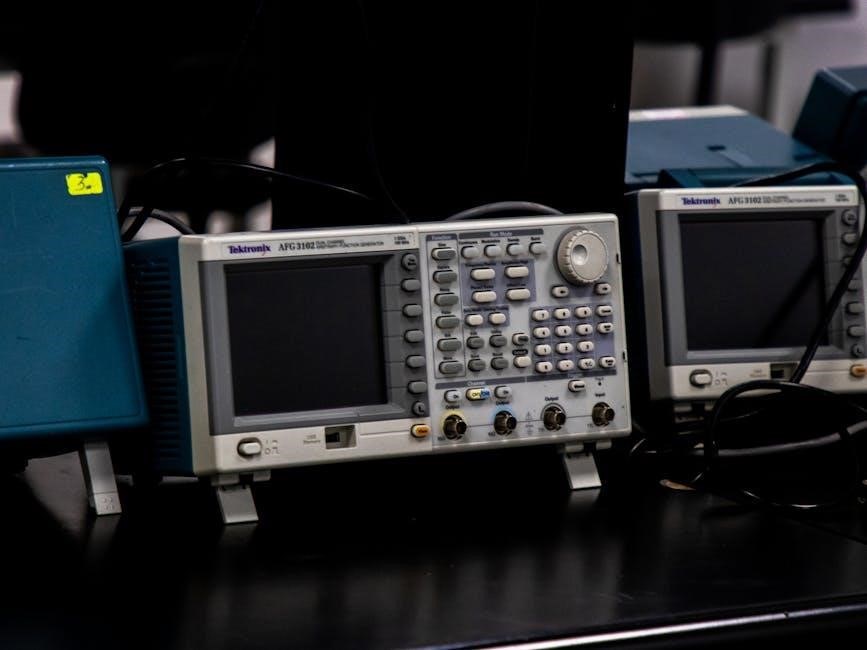Cable caliber and amperage tables are essential tools for designing safe and efficient electrical systems. They provide critical data on wire gauge, current capacity, and voltage drop, ensuring proper cable selection for various applications.
Overview of the Importance of Cable Caliber and Amperage
Understanding cable caliber and amperage is crucial for ensuring electrical systems operate safely and efficiently. Proper cable selection prevents overheating, fire hazards, and system failures. Caliber determines a cable’s current capacity, while amperage ratings ensure it can handle required loads without degradation. Factors like voltage drop, temperature, and insulation type also influence performance. Using standardized tables, such as the AWG system, helps designers and engineers select appropriate cables for specific applications, adhering to safety standards and optimizing system reliability.

Understanding the American Wire Gauge (AWG) System
The American Wire Gauge (AWG) system standardizes wire sizing, determining diameter and resistance. Larger AWG numbers indicate thinner wires with lower current capacity, ensuring proper cable selection for safe current flow.

Definition and Application of AWG in Cable Selection
The American Wire Gauge (AWG) is a standardized system for defining wire diameters, crucial for cable selection. It inversely relates gauge numbers to wire thickness—higher numbers indicate thinner wires. AWG tables provide essential data, including maximum current capacity (ampacity) and resistance, helping engineers select appropriate cables for specific electrical needs. This system ensures safe and efficient electrical system design by matching cable size to current requirements, minimizing risks of overheating and voltage drop. Proper AWG application is vital for reliability and compliance with electrical codes and standards.
How AWG Relates to Cable Diameter and Resistance
The American Wire Gauge (AWG) system defines wire diameter, with lower gauge numbers indicating thicker wires and higher numbers indicating thinner wires. As AWG increases, wire diameter decreases, leading to higher resistance due to less cross-sectional area. This relationship is critical for cable selection, as it directly impacts current-carrying capacity and energy efficiency. Thicker wires (lower AWG) can handle more current with less resistance, while thinner wires (higher AWG) are better suited for applications requiring flexibility over high current flow. AWG tables provide precise data for matching wire size to specific electrical demands.

Cable Ampacity and Its Significance
Cable ampacity refers to the maximum current a conductor can safely carry without overheating, ensuring efficient and reliable power distribution. It depends on conductor material, insulation, and environmental conditions, with standardized tables providing specific ratings for copper and aluminum cables. Proper understanding of ampacity is crucial for preventing thermal degradation and ensuring system safety. These ratings are essential for designing electrical systems that operate within safe limits, avoiding potential hazards like fire or equipment damage. Always consult updated tables for accurate ampacity values tailored to specific applications and conditions.
Maximum Current Ratings for Copper and Aluminum Conductors
Maximum current ratings for copper and aluminum conductors are specified in standardized tables, ensuring safe and efficient power distribution. Copper conductors generally have higher ampacity due to their superior conductivity, while aluminum conductors are more cost-effective but less efficient. These ratings are based on factors like conductor size, insulation type, and operating temperature, typically referenced at 75°C or 90°C. The tables provide detailed ampacity values for both materials, helping engineers design systems that meet specific requirements while maintaining safety and efficiency. Proper selection ensures reliable performance and prevents overheating risks.
Factors Influencing Cable Ampacity: Temperature, Insulation, and Environment
Temperature, insulation type, and environmental conditions significantly impact cable ampacity. Higher operating temperatures reduce a conductor’s current-carrying capacity due to increased resistance. Insulation ratings, such as THHN or THW, determine maximum allowable temperatures and influence ampacity. Environmental factors, like installation in conduits or direct burial, also affect heat dissipation. Tables account for these variables, providing adjusted ampacity values to ensure safe and efficient operation under specific conditions. Proper consideration of these factors is critical for designing reliable electrical systems and preventing overheating or fire hazards.

Voltage Drop Calculations in Cable Systems
Voltage drop calculations are crucial for ensuring efficient power delivery. They depend on cable length, current, and resistance. Tables provide voltage drop per 100 feet for various conductors, aiding system design.
Understanding Voltage Drop and Its Impact on System Efficiency
Voltage drop occurs when electricity flows through a cable, losing energy as heat. It depends on conductor size, material, and current. Excessive voltage drop can reduce system efficiency, causing equipment malfunction. Tables provide voltage drop values per 100 feet of cable, helping engineers select the right conductor size. Proper planning ensures minimal losses, maintaining system performance. Ignoring voltage drop can lead to inefficiency and safety hazards. Accurate calculations are vital for reliable and efficient electrical installations.
Calculating Voltage Drop per 100 Feet of Cable
Voltage drop per 100 feet of cable is calculated based on conductor size, material, and current flow. Tables provide specific values for copper and aluminum conductors at 80 power factor. For example, a 10 AWG copper cable has a voltage drop of 1.98 volts per 100 feet at 20 amps. Accurate calculations ensure minimal energy loss, maintaining system efficiency. Proper conductor sizing prevents excessive voltage drop, which can lead to equipment malfunction. These tables are essential for engineers to design reliable and efficient electrical systems, ensuring safety and performance.

Resistance and Reactance in AC Cable Systems

Resistance and reactance in AC systems are key for performance. Tables offer data on 75°C resistance and three-phase reactance, helping engineers optimize cable selection for efficiency and reliability.
Resistance in AC Systems at 75°C
Resistance in AC systems at 75°C is critical for cable performance. Tables provide detailed resistance values for copper and aluminum conductors, ensuring accurate voltage drop calculations. Higher temperatures increase resistance, reducing efficiency. Engineers use these tables to select cables that maintain performance under specific conditions, minimizing energy loss and ensuring reliability. Proper cable sizing based on resistance data is essential for safe and efficient electrical system design, particularly in high-temperature environments. This data is crucial for optimizing cable selection and maintaining system efficiency in various applications.
Reactance and Impedance in Three-Phase Systems
Reactance and impedance are critical in three-phase AC systems, influencing voltage and current relationships. Tables provide reactance values for copper and aluminum conductors at 75°C, essential for calculating impedance. Impedance combines resistance and reactance, affecting system efficiency. Higher reactance increases voltage drop, while impedance determines power transfer limits. Engineers use these tables to ensure proper conductor sizing, minimizing energy loss and maintaining system stability. Accurate reactance and impedance data are vital for efficient three-phase system design, especially in industrial applications where power quality is paramount.

Practical Applications of Cable Caliber and Amperage Tables
Cable caliber and amperage tables are vital for designing safe electrical systems, ensuring proper conductor sizing, and optimizing power distribution while minimizing energy loss and fire risks.
Designing Safe and Efficient Electrical Systems
Using cable caliber and amperage tables ensures electrical systems are both safe and efficient. Proper conductor sizing prevents overheating, reducing fire hazards while maintaining optimal performance. Tables provide maximum current ratings for copper and aluminum conductors, considering temperature, insulation, and environmental factors. This data helps engineers select appropriate cables for load requirements, ensuring reliable power distribution. Additionally, voltage drop calculations per 100 feet guide cable selection to minimize energy loss. Adherence to standards like AWG ensures compliance with safety regulations, protecting both equipment and users from potential risks.
Selecting the Right Cable for Specific Electrical Needs
Selecting the right cable involves matching its specifications to the electrical requirements of the system. Cable caliber and amperage tables provide detailed information on current capacity, voltage drop, and resistance for various conductor sizes. These tables help determine the appropriate AWG rating, ensuring the cable can handle the required current without overheating. Factors such as conductor material (copper or aluminum), insulation type, and environmental conditions also influence the selection process. By referencing these tables, engineers can ensure reliable performance, safety, and compliance with industry standards, optimizing system design for specific applications.

Safety Considerations and Compliance
Adhering to safety standards ensures reliable electrical installations. Compliance with NEC and NTC guidelines is crucial for preventing fire hazards and ensuring proper cable selection to avoid overheating and failures.
Standards and Regulations for Cable Installation
Compliance with national electrical codes like NEC and NTC is essential for safe cable installations. These standards provide guidelines for conductor sizing, temperature ratings, and insulation types. Proper adherence ensures systems operate within safe limits, reducing fire risks. Regulations also specify maximum conductor counts in conduits and required clearances. Always refer to updated tables for accurate compliance, ensuring installations meet legal and safety requirements. This guarantees reliability and efficiency in electrical systems, avoiding potential hazards.
Preventing Fire Hazards with Proper Cable Selection
Proper cable selection is crucial for preventing fire hazards in electrical systems. Overloaded or undersized cables can overheat, leading to fires. Using ampacity tables ensures cables are rated for the expected current, avoiding excessive heat buildup. Always choose cables with appropriate insulation ratings for the environment. Compliance with standards like NEC and NTC guarantees safe installations. Ignoring these guidelines can result in dangerous conditions. Prioritize fire safety by selecting cables that meet or exceed load requirements and environmental conditions, ensuring reliable and secure electrical systems.
Updated cable caliber and amperage tables are essential for accurate installations. Access reliable PDF resources like the NEC Table 310-15(b)(16) for detailed ampacity and sizing guidelines, ensuring compliance and safety in electrical systems.
Importance of Using Updated Cable Tables for Accuracy
Updated cable tables ensure precise ampacity ratings, voltage drop calculations, and compliance with safety standards. They reflect changes in materials, insulation types, and environmental factors, preventing oversized or undersized cable selections. Outdated tables can lead to safety hazards, inefficiencies, or non-compliance with regulations like NEC standards; Regularly referencing the latest PDF resources, such as NEC Table 310-15(b)(16), guarantees accurate designs and installations, minimizing risks and ensuring optimal system performance. Always verify the publication date to maintain reliability and adherence to current electrical codes.
Accessing Reliable PDF Resources for Cable Caliber and Amperage
Reliable PDF resources for cable caliber and amperage tables can be found through official electrical standards publications, such as the National Electric Code (NEC) or IEEE guidelines. Websites like Latin Casa and technical forums provide downloadable PDFs with detailed ampacity charts, voltage drop calculations, and wire gauge specifications. Ensure the PDFs are updated to reflect current standards, such as NEC Table 310-15(b)(16). Always cross-reference multiple sources to verify accuracy and compliance with local electrical codes for safe and efficient system design.



